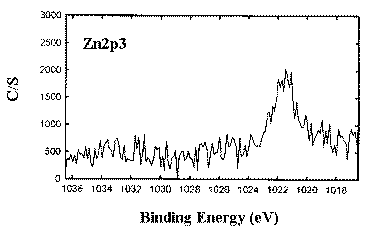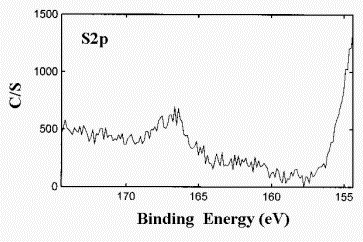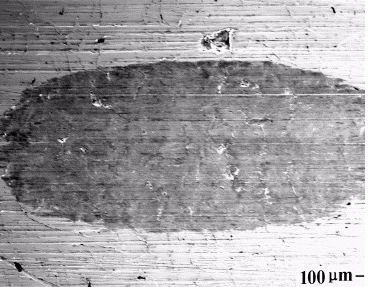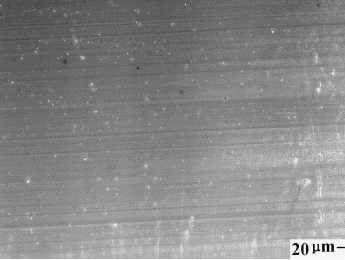TRIBOLOGICAL BEHAVIOR OF CAST IRON AND (Ca, Mg)-SIALON UNDER LUBRICATION
Wenguang Zhang1) Weimin Liu1)* Laigui Yu1) Czesaw Kajdas2)
Key words: Sialon; (Ca, Mg)-Sialon; cast iron; lubrication; friction and wear behaviors
Published in: , nr 3, 1998, s. 389
1)State Key Laboratory of Solid Lubrication, Lanzhou Institute of Chemical Physics, Chinese Academy of Sciences, Lanzhou 730000, P.R. China, tel.(86)931-, fax(86)931-8417088, e-mail: wmliu @ ns.lzb.ac.cn
2)Institute of Chemistry, Warsaw Technical University in Plock, 00-400 Plock, Poland, tel. (024) 36-72-191, fax (024) 262-74-94, e-mail: ckajdas @ zto.pw.plock.pl
*Corresponding author
ABSTRACT
INTRODUCTION
EXPERIMENTAL DETAILS
The physical and mechanical properties of the tested Sialon and (Ca, Mg)-Sialon are shown in Table 1 and Table 2, respectively. Analytically pure commercial ZDDP, TCP, SO, decanol and methanol were selected as the additives which were added in LP base stock at a mass fraction 2%. The same mass fraction of the additives was also selected for the additive combinations of ZDDP+ decanol and ZDDP+methanol.
Tabela 1
Physical and mechanical properties of Sialon
Materials Density
(g/cm³) Young's modulus
(MPa) Hardness
(HV/Pa) Bend strength
(MPa) Fracture toughness
(K1C/M Pa·m½)
Sialon >3.19 3.5•105 1200 700 6÷8
Tabela 2
Physical and mechanical properties of (Ca,Mg)-Sialon
Material Density
(g/cm³) Porosity
(%) Hardness
(HV/Pa) Fracture toughness
(K1C/M Pa·m½)
(Ca,Mg)-Sialon 3.20 0.49 2021 5.5
Prior to the friction and wear test, all the samples were cleaned in an ultrasonic bath with acetone for 20 min, then dried in hot air. The friction and wear tests were conducted on an SRV test rig in a ball-on-block configuration by sliding the stationary cast iron or (Ca, Mg)-Sialon block of size 19 mm×19 mm×8 mm against the reciprocating Sialon ball of f 10 mm. The testing conditions are: amplitude 1 mm, frequency 25 Hz, linear speed 0.05 m s-1, test duration 25 min., relative humidity 43%-56%, and normal load 80 N or 200N load. The deviation of the friction and wear test data was below 10%. The coefficient of friction was recorded automatically. The width and depth of the wear scar were determined with a profilometer, then the wear volume losses were calculated. X-ray photoelectron spectroscopic (XPS) analysis of the worn surfaces was conducted on a PHI-5702 multifunctional X-ray photoelectron spectrometer with Mg-ka radiation operating at 250 W and a pass energy of 29.35 eV. The binding energy of C1s (284.6 eV) was used as the reference. The morphologies of the worn (Ca, Mg)-Sialon, cast iron block surfaces and the distribution of transferred typical elements therein were examined with a JSM-5600LV electron probe microanalyzer (EPMA).
RESULTS AND DISCUSSION
FRICTION AND WEAR BEHAVIORS
SIALON/CAST IRON
The friction coefficient of Sialon sliding against cast iron is summarized in Table 3. It can be seen that LP and LP doped with various additives or their combinations show little difference in friction-reducing behavior. The only exception is that SO/LP registers higher initial friction coefficient which decreases with increase of test duration and finally comes to the lowest among all the tested additives in this work.
The wear volume loss of cast iron and the wear scar diameter (WSD) of Sialon at 80N is presented in Fig. 1. As shown in Fig. 1(a), almost the same wear volume losses are recorded for cast iron lubricated with LP, ZDDP/LP, and decanol/LP. A lowered wear volume loss of cast iron is only obtained under the lubrication of ZDDP and decanol as the combined additives. The other additives including methanol, ZDDP+methanol, TCP, and SO all increase the wear volume loss of cast iron. The order of wear volume loss of cast iron can be ranked as: SO>ZDDP+methanol>TCP>methanol>LP>ZDDP, decanol>ZDDP+decanol. Accordingly, it is inferred that a synergism in decreasing wear exists for ZDDP and 1-decanol, which could be attribute to their medium reactivity with both cast iron and Sialon. 1-decanol can react with Sialon to form a tribochemcial film with good lubricity [6], thus to prevent the direct contact between Sialon and cast iron or (Ca, Mg)-Sialon, thereby abating the abrasive wear. Contrary to the above, an antagonism in reducing wear accounts for the higher wear volume loss of the cast iron block lubricated with ZDDP and methanol as the combined additives in LP. This could be attributed to the corrosive effect of methanol. Similarly, the highest wear volume of cast iron lubricated with SO/LP is attributed to the strongest corrosive effect of SO therein. Besides, as shown in Fig. 1(b), the additives have almost no effect on the wear-resistance of Sialon except that ZDDP plus decanol in LP decreases the wear scar diameter slightly while SO/LP increases the wear scar diameter considerably.
Tabela 3
Friction coefficient of Sialon sliding against cast iron at various lubricated conditions
Lubricant LP ZDDP TCP SO Decanol Methanol ZDDP+decanol ZDDP+methanol
Coefficient
of Friction 0.08 0.09 0.08 0.10÷0.07 0.08 0.08 0.07 0.07
(Linear speed: 0.05 ms-1; test duration: 25 min; and normal load: 80 N)
SIALON/(CA, MG)-SIALON
The friction coefficient of Sialon sliding against (Ca, Mg)-Sialon under the lubrication as a function of the test duration is shown in Fig. 2. It is seen that all the additives decrease the friction coefficient to some extent as compared with LP alone, though they show little difference in friction-reducing behavior among themselves. This is different from what has been observed for Sialon/cast iron system. A synergistic friction-reducing effect is also observed for ZDDP and 1-decanol in Sialon/(Ca, Mg)-Sialon system, similar to that in Sialon/cast iron system.
The wear scar diameter (WSD) of Sialon sliding against (Ca, Mg)-Sialon under lubrication is presented in Fig.3, where the wear volume loss of (Ca, Mg)-Sialon block is also given for a comparison. It is seen that all the additives and additive combination are effective in reducing wear of both Sialon and (Ca, Mg)-Sialon, though they show some difference at 200N load than at 80N. Namely, ZDDP/LP is the most effective one to reduce wear of (Ca, Mg)-Sialon in sliding against Sialon, regardless of the load applied. However, almost the same wear scar diameter of the Sialon ball is recorded at 80N under the lubrication of ZDDP/LP, (ZDDP+decanol)/LP, TCP/LP, and SO/LP. This indicates that the same lubricant does not necessarily show the same effect on the friction and wear behaviors of Sialon and (Ca, Mg)-Sialon. In other words, ZDDP/LP is comparable to (ZDDP+decanol)/LP, TCP/LP, and SO/LP in reducing the wear of the Sialon ball sliding against (Ca, Mg)-Sialon block under 80 N. In consideration of the observation that the wear volume loss of (Ca, Mg)-Sialon block lubricated with ZDDP/LP at 80N is too small to detect in this work, the wear volume loss of (Ca, Mg)-Sialon at 80N can be ranked as ZDDP+decanol≈decanol, LP>TCP, SO>ZDDP; that at 200N ranked as LP>SO, 1-decanol>ZDDP+1-decanol>TCP≈ZDDP. The order of WSD of Sialon at 80N is ranked as LP>1-decanol>ZDDP+1-decanol≈SO, TCP, ZDDP, that at 200N ranked as LP>SO>ZDDP+1-decanol>1-decanol>TCP>ZDDP. Thus in a comprehensive sense, ZDDP is the optimal additive in LP for reduction of friction and wear of Sialon-(Ca, Mg)-Sialon system. This is different from what has been observed in Sialon-cast iron system where the combined additive of ZDDP and decanol shows the best friction-reduction and antiwear behaviors.
XPS ANALYSIS OF THE WORN SURFACES
XPS is applied to detect the chemical states of some typical elements on the worn surface of cast iron and (Ca, Mg)-Sialon, respectively. The XPS spectra of the elements on the worn surface of cast iron lubricated with LP containing various additives are shown in Fig. 4. The binding energy of S2p at 168.40 eV is consistent with that of FeSO4 [7-8], indicating that SO as an additive in LP experienced tribochemical reaction during the sliding process of Sialon against cast iron. The binding energy of Zn2p at 1021.4. eV is consistent with that of ZnO or ZnS, which is much different form that of ZDDP at 1024.2 eV, indicating that ZDDP decomposed during the friction process. This is in agreement with what was reported by Wei et al [9] who claimed that that ZDDP decomposed thermally by ß-hydrogen elimination and nucleophilic substitution under friction. The binding energy of S2p at 162.10 eV is far from that of ZnS at 164.0 eV [8], indicating that no ZnS is generated on the worn surface of cast iron. Subsequently ZnO is possibly one of the main components of the decomposed products of ZDDP, accompanied by some S-containing compounds such as RSH and RSSR [9]. The binding energy of P2p at 133.1eV is lower than that of ZDDP at 133.7 eV and of PO43- at 134.0 eV [9-10], which indicates the generation of some kind S-P compound [11]. It should be pointed out that the XPS peak of P2p on the cast iron worn surface lubricated with TCP and ZDDP is too weak to be detected. The XPS spectra of the elements on the worn surface of (Ca, Mg)-Sialon block are shown in Fig.5. The XPS peaks of P2p and Zn2p on the worn surface lubricated with ZDDP are also too weak to be detected. Interestingly, those on the worn surface lubricated with ZDDP+1-decanol are much stronger, which could have some relation with the synergistic effect of the two additives. The binding energy of P2p at 134.0 eV is possibly attributed to some kind phosphate [9-10]. While the binding energy of Zn2p3 at 1021.7 eV is attributed to ZnSO4 [12-13]. The binding energy of P2p at 133.80 eV under the lubrication of TCP is close to that under lubrication of ZDDP+1-decanol, indicating that similar compounds were produced in these two cases. The binding energy of S2p at 166.70 eV under the lubrication of SO is higher than that of SO and lower than that of SO42-, which is probably attributed to some kind organic S-containing compound or sulfite [7]. This is different from what is observed in the Sialon/cast iron system.
According to the above-mentioned XPS analytical results of the worn surfaces of cast iron and (Ca, Mg)-Sialon, it can be concluded that both ZDDP and SO decomposed during the friction process, with the generation of different products on the surfaces of cast iron and (Ca, Mg)-Sialon. It can be further concluded that decomposition and deposition of the EP additives mainly account for their lubricity in the ceramic system, which agrees well with what was reported by Wei et al [14] but disagrees with that reported by Studt [15].
SEM AND EPMA ANALYSIS OF THE WORN SURFACES
In order to make clear the friction and wear mechanisms, the worn surfaces of cast iron and (Ca, Mg)-Sialon were observed by SEM equipped with EDS. As shown in Fig 6, deep grooves exist on the worn surface of cast iron lubricated with LP alone, indicating that abrasive wear dominates the wear in this case [see Fig 6(a)]. A smoother surface is obtained and heavy abrasive wear avoided under the lubrication of SO/LP [see Fig 6(b)]. The worn surface of cast iron lubricated with TCP/LP and ZDDP/LP is relatively rough and shows some signs of adhesion, as shown in Figures 6 (c and d). It is interesting to note that the worn surfaces of cast iron lubricated with ZDDP and ZDDP plus decanol as indicated in Figures 6(e and g), are both smooth and show almost no signs of abrasive wear or plastic deformation, in agreement with the corresponding friction and wear behaviors discussed in Table 3 and Figure 1. Moreover, the worn surfaces of (Ca, Mg)-Sialon under the lubrication of ZDDP at 80 N is smooth in the mild area [see Fig 7(a)] while some signs of scuffing and fine pits are visible on the magnified SEM picture in the sever area [see Fig 7(b)]. The latter indicates that weak corrosion may happen under this condition. The worn surfaces of (Ca, Mg)-Sialon under the lubrication of ZDDP/LP at 200 N shows obvious signs of cracking and pitting [see Figures 7(c and d)], which corresponds to the pulling out of the crystal grain under friction stress and corrosion. The worn surface of (Ca, Mg)-Sialon lubricated with TCP/LP as indicated in Figures 7(e and f) shows the same features as that lubricated with ZDDP/LP. Different from above, the worn surface of (Ca, Mg)-Sialon lubricated with SO/LP is characteristic of more small pits and micro-cracks as shown in Figures 7 (g and h), which corresponds to the poor tribological performances. The signs of severe fracture and many micro-cracks are observed on the worn surface of (Ca, Mg)-Sialon lubricated with LP alone [see Figures 7 (i and j)]. This is in agreement with the friction and wear behavior of (Ca, Mg)-Sialon discussed above.
FRICTION AND WEAR MECHANISM
Alcohol, EP/AW additives and the decomposed products of EP/AW additives such as phosphate are easy to adsorb on the worn surfaces of cast iron and Sialon, with the formation of adsorption film thereon. Such an adsorption film is usually effective in reducing friction and wear under lower load but less effective at higher loads because of the expectable desorption therewith. In the latter case, the decomposition of the additives and the resultant formation of desired decomposed products on the lubricated surface are key to improve the friction and wear behaviors of the frictional pair, as discussed in XPS analysis of the worn surfaces. When alcohol and ZDDP were used as the combined additive, a competitive adsorption between alcohol and ZDDP is rationally to occur, accompanied by tribochemical decomposition of both ZDDP and alcohol. The better wear-reducing ability of TCP and ZDDP in LP can be well understood by taking into account their decomposed acidic products on the lubricated surfaces. It is known that many oxide such as SiO2 and Al2O3 are solid acids while under friction charged particles are emitted from the couple surfaces, especially for ceramic system, which provide abundant chances for decomposition process [16-18]. We found in our previous work [6, 19-20] that the organic acidic compound show better lubricity in lubricating ceramics than alcohol, though alcohol can react with the surface of Sialon under friction. It has been widely accepted that EP additives or its decomposed products can react with the iron surface. These tribochemcial reactions can be beneficial or harmful to the tribological behaviors of the lubricated frictional pair, depending on the properties of the tribochemcial products. Since alcohol and the EP additive such as SO lead to corrosive wear of both ceramics and cast iron, it is not hard to find that they are not the optimal candidate for reducing friction and wear of cast iron and Sialon ceramics in this work.
CONCLUSION
From above, the following conclusions can be drawn:
- ZDDP, TCP and SO are not suitable in lubricating Sialon/cast iron system. There exists a synergism between ZDDP and methanol in reducing friction but antagonism in reducing wear. ZDDP and 1-decanol as the combined additive in liquid paraffin show synergism in reducing friction and wear of both Sialon and cast iron at extended test duration.
- Both TCP and ZDDP show good anti-wear ability in Sialon/(Ca, Mg)-Sialon system. SO register relatively good anti-wear ability at 80N but very weak anti-wear ability at 200N for Sialon/(Ca, Mg)-Sialon system. A synergism in reducing wear is also observed for ZDDP and 1-decanol in this case.
- ZDDP and 1-decanol as the combined additive in liquid paraffin register the best friction-reduction and wear-decreasing behavior for both Sialon/cast iron and Sialon/(Ca, Mg)-Sialon systems. The additives act to reduce wear by forming an adsorption boundary lubricating film on the lubricated surface at lower loads. These additives experience tribochemcical decomposition at higher loads and lead to corrosive wear of ceramics as well. This is especially so for SO.
- Wear of the cast iron tested in this work is characteristic of abrasive wear, that of the Sialon ceramics is dominated by abrasive wear, corrosive pitting, and micro-cracking.
ACKNOWLEDGEMENT
The authors would like to acknowledge Engineer Qi Shang-kui and Zhao Jia-zheng for their assistance in XPS and EPMA analyses. They also thank to the generous support of the National Natural Science Foundation of China (Grant No. 59825116) and Chinese Academy of Sciences.
REFERENCES
- Gates R. and Hsu S.: Silicon nitride boundary Lubrication: Lubrication mechanisms of alcohols, STLE Preprint, 94-TC-4C-2.
- Hibi Y. and Enomoto Y.: Lubrication and tribochemical reaction of silicon nitride in lower alcohols. In Proceedings of 3rd Sino-Japan Symposium on Tribology, Lanzhou, China, September 1996.
- Hibi Y., Enomoto Y.: Mechanochemical reaction and relationship to tribological response of silicon nitride in n-alcohol. Wear, 231, 1999, 185-194
- Kajdas C., Obadi M.: Effect of straight chain alcohols C4-C14 in hexadecane on wear of steel-on-steel tribological elements. In: Proceedings of symposium on lubricating materials and tribochemistry, edited by LSL, 1998, Lanzhou P. R. China, 83-94.(4)
- Zhang W., Liu W., Liu H., Yu L., Xue Q.: Tribological behaviors of (Ca, Mg)-Sialon under lubricating of polyols. Wear?223, 1998, 143-149.
- Zhang W., Li Y., Zhang J., Liu W., Wang P., Sun W.: Tribological behaviors of (Ca, Mg)-Sialon against steel with the lubrication of alcohols. J of inorganic materials, 14, 1999, 975~980.
- Lindberg B.J., Hamrin K., Johansson G., Gelius V., Fahlmann A., Nordling C., Siegbahn, K., Phys. Scr., 1, 1970, 286.
- Limouzin-maire Y., Bull. Soc. Chim. Fr. 1, 1981, 340.
- Wei.J., and Xue. Q.: tribochemical mechanism of Si3N4 with additives. Wear, 162-164, 1993, 1068-1072.
- Swift P. Surf. Interface Anal., 4, 1982, 47.
- Fluck E. Weber D. Z. Anorg. Allg. Chem., 412, 1975, 47.
- Gaarenstroom S.W., Winograd N., J. Chem. Phys., 67, 1977, 3500.
- Nefedov, V.I., J. Electron Spectrosc. Relat. Phenom., 25, 1982, 29.
- Wei J., Xue J., Wear, 157, 1992, 173.
- Studt P. Tribo. Inter., 22, 1989, 111.
- Jahanmir S. and Fischer T. E.: Friction and Wear of Si3N4 Lubricated by humid air, Water, hexadecane and hexadecane +0.5 percent steric acid. STLE Trans., 31, 1986, 32-43.
- Tanabe, K., Solid acids and bases, Kodansha, Tokyo and Academic Press, New York, 1970
- Fisher, T. E., Catalysis and surfaces, J. Vac. Sci. and Tech., 11, 1974, 252; Fisher, T. E., A new look at catalysis, Physics today, 27, 1974, 23.
- Zhang W., Liu W., Yang S., Liu C., Xue. Q.: Investigations of the Friction Mechanisms of SiO2 under Dry Sliding and Lubrication, Tribology, in press. (in chinese)
- Zhang W., Liu W.: Tribological behaviors of N and/or O -containing lubricants in Lubricating (Ca, Mg)-Sialon, submitted to Lubr. Sci.


Fig. 1 Wear volume of Cast iron and wear scar diameter (WSD) of Sialon under lubrication at 80N

Fig. 2 Friction coefficient of Sialon sliding against (Ca, Mg)-Sialon as a function of time under the lubrication of ZDDP, alcohol and their mixture (80N)


Fig. 3 Wear volume of (Ca, Mg)-Sialon and wear scar diameter (WSD) of Sialon ball under lubrication
Tabela 1 | |||||||||||
| Materials | Density (g/cm³) | Young's modulus (MPa) | Hardness (HV/Pa) | Bend strength (MPa) | Fracture toughness (K1C/M Pa·m½) | ||||||
| Sialon | >3.19 | 3.5•105 | 1200 | 700 | 6÷8 | ||||||
Tabela 2 | |||||||||||
| Material | Density (g/cm³) | Porosity (%) | Hardness (HV/Pa) | Fracture toughness (K1C/M Pa·m½) | |||||||
| (Ca,Mg)-Sialon | 3.20 | 0.49 | 2021 | 5.5 | |||||||
RESULTS AND DISCUSSION
FRICTION AND WEAR BEHAVIORS
SIALON/CAST IRON
Tabela 3 | |||||||||||
| Lubricant | LP | ZDDP | TCP | SO | Decanol | Methanol | ZDDP+decanol | ZDDP+methanol | |||
|
Coefficient of Friction | 0.08 | 0.09 | 0.08 | 0.10÷0.07 | 0.08 | 0.08 | 0.07 | 0.07 | |||
| (Linear speed: 0.05 ms-1; test duration: 25 min; and normal load: 80 N) | |||||||||||
SIALON/(CA, MG)-SIALON
XPS ANALYSIS OF THE WORN SURFACES
SEM AND EPMA ANALYSIS OF THE WORN SURFACES
FRICTION AND WEAR MECHANISM
CONCLUSION
-
From above, the following conclusions can be drawn:
- ZDDP, TCP and SO are not suitable in lubricating Sialon/cast iron system. There exists a synergism between ZDDP and methanol in reducing friction but antagonism in reducing wear. ZDDP and 1-decanol as the combined additive in liquid paraffin show synergism in reducing friction and wear of both Sialon and cast iron at extended test duration.
- Both TCP and ZDDP show good anti-wear ability in Sialon/(Ca, Mg)-Sialon system. SO register relatively good anti-wear ability at 80N but very weak anti-wear ability at 200N for Sialon/(Ca, Mg)-Sialon system. A synergism in reducing wear is also observed for ZDDP and 1-decanol in this case.
- ZDDP and 1-decanol as the combined additive in liquid paraffin register the best friction-reduction and wear-decreasing behavior for both Sialon/cast iron and Sialon/(Ca, Mg)-Sialon systems. The additives act to reduce wear by forming an adsorption boundary lubricating film on the lubricated surface at lower loads. These additives experience tribochemcical decomposition at higher loads and lead to corrosive wear of ceramics as well. This is especially so for SO.
- Wear of the cast iron tested in this work is characteristic of abrasive wear, that of the Sialon ceramics is dominated by abrasive wear, corrosive pitting, and micro-cracking.
ACKNOWLEDGEMENT
REFERENCES
- Gates R. and Hsu S.: Silicon nitride boundary Lubrication: Lubrication mechanisms of alcohols, STLE Preprint, 94-TC-4C-2.
- Hibi Y. and Enomoto Y.: Lubrication and tribochemical reaction of silicon nitride in lower alcohols. In Proceedings of 3rd Sino-Japan Symposium on Tribology, Lanzhou, China, September 1996.
- Hibi Y., Enomoto Y.: Mechanochemical reaction and relationship to tribological response of silicon nitride in n-alcohol. Wear, 231, 1999, 185-194
- Kajdas C., Obadi M.: Effect of straight chain alcohols C4-C14 in hexadecane on wear of steel-on-steel tribological elements. In: Proceedings of symposium on lubricating materials and tribochemistry, edited by LSL, 1998, Lanzhou P. R. China, 83-94.(4)
- Zhang W., Liu W., Liu H., Yu L., Xue Q.: Tribological behaviors of (Ca, Mg)-Sialon under lubricating of polyols. Wear?223, 1998, 143-149.
- Zhang W., Li Y., Zhang J., Liu W., Wang P., Sun W.: Tribological behaviors of (Ca, Mg)-Sialon against steel with the lubrication of alcohols. J of inorganic materials, 14, 1999, 975~980.
- Lindberg B.J., Hamrin K., Johansson G., Gelius V., Fahlmann A., Nordling C., Siegbahn, K., Phys. Scr., 1, 1970, 286.
- Limouzin-maire Y., Bull. Soc. Chim. Fr. 1, 1981, 340.
- Wei.J., and Xue. Q.: tribochemical mechanism of Si3N4 with additives. Wear, 162-164, 1993, 1068-1072.
- Swift P. Surf. Interface Anal., 4, 1982, 47.
- Fluck E. Weber D. Z. Anorg. Allg. Chem., 412, 1975, 47.
- Gaarenstroom S.W., Winograd N., J. Chem. Phys., 67, 1977, 3500.
- Nefedov, V.I., J. Electron Spectrosc. Relat. Phenom., 25, 1982, 29.
- Wei J., Xue J., Wear, 157, 1992, 173.
- Studt P. Tribo. Inter., 22, 1989, 111.
- Jahanmir S. and Fischer T. E.: Friction and Wear of Si3N4 Lubricated by humid air, Water, hexadecane and hexadecane +0.5 percent steric acid. STLE Trans., 31, 1986, 32-43.
- Tanabe, K., Solid acids and bases, Kodansha, Tokyo and Academic Press, New York, 1970
- Fisher, T. E., Catalysis and surfaces, J. Vac. Sci. and Tech., 11, 1974, 252; Fisher, T. E., A new look at catalysis, Physics today, 27, 1974, 23.
- Zhang W., Liu W., Yang S., Liu C., Xue. Q.: Investigations of the Friction Mechanisms of SiO2 under Dry Sliding and Lubrication, Tribology, in press. (in chinese)
- Zhang W., Liu W.: Tribological behaviors of N and/or O -containing lubricants in Lubricating (Ca, Mg)-Sialon, submitted to Lubr. Sci.
 |

|
| Fig. 1 Wear volume of Cast iron and wear scar diameter (WSD) of Sialon under lubrication at 80N | |

| |
| Fig. 2 Friction coefficient of Sialon sliding against (Ca, Mg)-Sialon as a function of time under the lubrication of ZDDP, alcohol and their mixture (80N) | |
 |

|
| Fig. 3 Wear volume of (Ca, Mg)-Sialon and wear scar diameter (WSD) of Sialon ball under lubrication | |

























